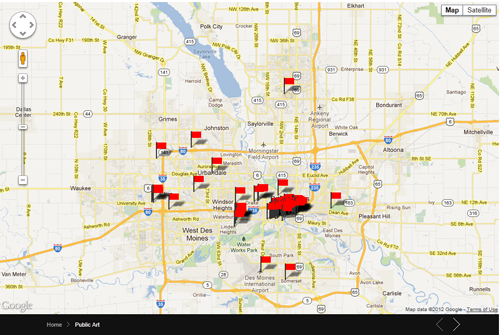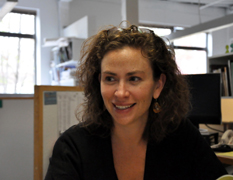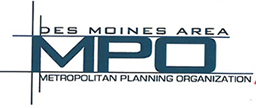While the S&P 500, commonly considered a bellwether for the American economy, was essentially flat for 2011, art showed a return of 10.2% as an asset class in 2011, according to the Mei Moses World All Art Index (MMAI).[1] Investing in art is not only good for your bottom line, but also for your community. Investing in art can range from buying and displaying art to arts education and coordination. Similar to the focus of The Tomorrow Plan, it can create a dialogue for social and cultural change and have a positive economic impact on the community. Locally, there are many great arts organizations, with several operating at the regional scale and engaging a diverse community.
The Greater Des Moines Public Art Foundation (GDMPAF) increases cultural awareness by establishing Des Moines as a world class destination for public art. The same public art that attracts visitors can shape and inspire us as individuals, cultures, and communities. When entered into in a spirit of enthusiasm and energy, these collaborations not only contribute to the enhancement and understanding of public places, but support an area’s wider strategies for economic, social and cultural development.[2]
 GDMPAF map of public art locations throughout Greater Des Moines.
GDMPAF map of public art locations throughout Greater Des Moines.
The Des Moines Social Club (DMSC) uses the arts as a catalyst to create community engagement. DMSC’s vision is “to build premier arts institutions that foster social change and revitalize cities throughout the world.” Bringing together board members of all ages, the Des Moines Social Club provides thought-provoking theater, classes for people of all ages, promotion for local artists, and a recruiting tool for the many businesses in Downtown Des Moines.[3]
Connecting Kids and Culture is an initiative to enhance student learning by providing greater access to the educational programs of Des Moines area arts and cultural organizations. The program connects students and school district curriculum with arts and cultural experiences in Des Moines community.[4] By creating a connection between elementary school students’ diverse subject areas and arts and cultural experiences around the greater Des Moines area, the organization is educating the next generation on the importance of the arts as a part of a sustainable future.
The Tomorrow Plan is working with communities and organizations across the area to develop a comprehensive approach to future development and coordination within the region. Many organizations are already promoting regional cooperation and economic sustainability, including the Bravo Greater Des Moines Regional Arts Council (Bravo). Bravo is working to strengthen the metro area’s arts and cultural community as a key element of a world-class quality of life, while at the same time, creating a positive economic impact for the community.[5] “In addition to improving the local quality of life, arts and culture make an important contribution to the area economy. According to a 2001 study of the metro’s largest cultural institutions, arts and cultural activity generated $58 million in central Iowa’s economy, including 1,650 jobs. Organizations hosted over 2.3 million visitors and more than 365,000 individuals benefited from quality education and outreach programs. The report found that Bravo-funded organizations’ total economic values yielded $74.96 million in output in the region, $37.1 million in value added, of which $25.6 million found its way into labor incomes supporting a total of 1,755 central Iowa jobs.”
Around the country, the discussion of the arts and its impact has been elevated to a much broader dialogue that focuses on its importance as part of a sustainable regional future. Rust Belt to Artist Belt is now an annual conference that “brings together artists of all disciplines, community organizers, social service providers, educators, architects, funders, academics, creatives, and policy-makers to create the foundation for a sustained dialogue that connects an entire creative supply chain.” Artists themselves are also having an impact on the future of cities and the sustainability dialogue. Trained as an urban planner and sculptor, Chicago artist Theaster Gates, “transforms spaces, institutions, traditions, and perceptions in his performances, installations, and urban interventions.” Through his work, Gates is “committed to the restoration of poor neighborhoods, converting abandoned buildings into cultural spaces that allow not only new cultural moments to happen in unexpected places, but raising the city’s expectations of where “place-making” happens and why.”[6] Gates is taking part in an upcoming performance at the Institute for Contemporary Art in Boston. Red, black, GREEN: a blues (rbGb) combines art and sustainability into a performance “to initiate a dialogue about environmental justice, social ecology, and collective responsibility in an era of climate change. Through poetry and performance highlighted by vivid films and vibrant murals, rbGb presents the idea that nurturing our lives and communities are the first steps in nurturing our planet.[7]
How has art influenced your commitment to a Greener, Greater Des Moines?
 Lynn Carlton is the project manager and senior planner on the Sasaki Team for The Tomorrow Plan. Lynn grew up in Kansas City and has participated in arts and cultural events her entire life as a way to experience and contribute to city life. In Boston, she is currently involved with the Institute for Contemporary Art and Artists for Humanity.
Lynn Carlton is the project manager and senior planner on the Sasaki Team for The Tomorrow Plan. Lynn grew up in Kansas City and has participated in arts and cultural events her entire life as a way to experience and contribute to city life. In Boston, she is currently involved with the Institute for Contemporary Art and Artists for Humanity.
[1] http://www.time.com/time/magazine/article/0,9171,2104838,00.html
[2] http://dsmpublicartfoundation.org/about/
[3] http://desmoinessocialclub.org/sample-page
[4] http://www.connectingkidsandculture.org/index.php
[5] http://www.bravogreaterdesmoines.org/
[6] http://theastergates.com/home.html
[7] http://www.icaboston.org/programs/performance/rbGb_ablues/




